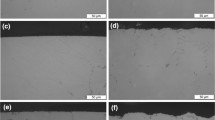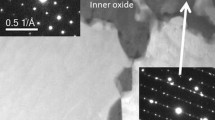Abstract
Despite their extraordinary properties, superalloys are subject to hot corrosion; a phenomenon potentially leading to catastrophic failure of turbine blades. However hot corrosion is understood to be highly temperature dependent, undergoing different reaction rates and even reaction mechanisms with changing alloy temperature. As such, a detailed understanding of the variation in rates of damage with temperature is required when producing superalloy components for use in sectors such as aerospace and energy. This article outlines a novel method for rapidly acquiring temperature-dependent hot corrosion data for superalloys in the temperature range 600–1000 °C. The technique is illustrated for the aerospace superalloy, CMSX-4, generating results that localise peak hot corrosion damage at 725 °C (Type II) and 900 °C (Type I).










Similar content being viewed by others
References
N. Eliaz, G. Shemesh and R. M. Latanision, Engineering Failure Analysis 9, 2002 (31).
M. Donachie, J. Donachie and J. Stephen, Superalloys—A Technical Guide, 2nd ed, (ASM International, Materials Park, 2002), p. 298.
J. R. Nicholls, K. J. Lawson, L. H. Al Yasiri and P. Hancock, Corrosion Science 35, 1993 (1209).
K. L. Luthra and O. H. LeBlanc, Materials Science and Engineering 87, 1987 (329).
M. W. Brumm and H. J. Grabke, Corrosion Science 33, 1992 (1677).
F. Pettit, Oxidation of Metals 76, 2011 (1).
J. Sumner, A. Encinas-Oropesa, N. J. Simms and J. R. Nicholls, Materials and Corrosion 65, 2014 (188).
J. Sumner, A. Potter, N. J. Simms and J. E. Oakey, Materials at High Temperatures 32, 2015 (17).
V. Deodeshmukh and B. Gleeson, Environmental and Compositional Effects on the Hot-Corrosion Behaviour of Ni-Based Alloys and Coatings, (NACE International, New Orleans, 2008).
J. Błachnio and W. I. Pawlak, in Advances in Gas Turbine Technology. Chapter 19, ed. E. Benini (InTech, Rijeka, 2011), p. 441.
J. R. Nicholls, MRS Bulletin 28, 2003 (659).
S. Kamala, R. Jayaganthana, S. Prakasha and S. Kumarb, Journal of Alloys and Compounds 463, 2008 (358).
Z. Tang, F. Wang and W. Wu, Materials Science and Engineering A 276, 2000 (70).
N. J. Simms, A. Encinas-Oropesa and J. R. Nicholls, Materials and Corrosion 59, 2008 (476).
M. P. Taylor, H. E. Evans, S. Gray and J. R. Nicholls, Materials and Corrosion 62, 2011 (668).
H. Haight, J. Sumner, S. Gray, MSc Thesis, Cranfield University (2014).
J. R. Nicholls, N. J. Simms and A. Encinas-Oropesa, Materials at High Temperature 24, 2007 (149).
J. Sumner, A. Encinas-Oropesa, N. J. Simms and J. E. Oakey, Materials Science and Technology 29, 2013 (813).
S. Pahlavanyali, H. T. Pang, F. Li, S. Bagnall and C. Rae, MST 30, 2014 (1890).
Acknowledgments
Humphrey Haight would like to acknowledge the assistance of A Potter, T Roberts and L Butler.
Author information
Authors and Affiliations
Corresponding author
Rights and permissions
About this article
Cite this article
Haight, H., Potter, A., Sumner, J. et al. New Technique to Map Hot Corrosion Damage: CMSX-4 Example. Oxid Met 84, 607–619 (2015). https://doi.org/10.1007/s11085-015-9590-z
Received:
Revised:
Published:
Issue Date:
DOI: https://doi.org/10.1007/s11085-015-9590-z




